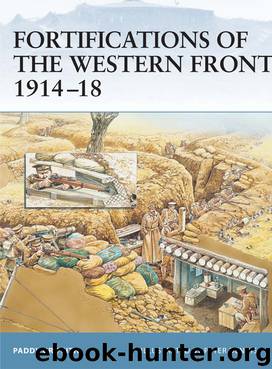Fortifications of the Western Front 1914-18 by Paddy Griffith

Author:Paddy Griffith
Language: eng
Format: epub
Tags: Fortifications of the Western Front 1914–18
ISBN: 9781472805263
Publisher: Osprey Publishing
Published: 2013-06-11T16:00:00+00:00
Firing ports for machine guns in the north-west counterscarp gallery in the main ditch at Fort Douaumont, Verdun. Note that the original stone walls of the late 19th century have been topped by a stronger concrete crust in the early 20th. (Paddy Griffith)
Absolutely all movements by the garrisons were to be through underground concrete tunnels, safe from enemy interference. In the main ditches of such forts the fragile and near-vertical masonry scarp walls were to be smoothed out into gentle earth slopes that could absorb shelling with ease, at the base of which there would be little more than simple wire entanglements or iron railing grilles flanked by machine guns firing from concrete galleries set in the counter-scarp. The cost of all this, apart from the heavy financial one, was that the whole purpose of any fort now became narrowly re-defined as merely the preservation of a very few armoured artillery guns located on key topographical features, from which their fire could cover the ground betwen that fort and the next. As far as the rest of the battle was concerned, the line infantry was expected to dig trenches and other fieldworks in front of and between the forts, which effectively meant that the fixed forts were supposed to be defended by other troops. Equally the mass of the field artillery was relegated to the dead ground behind the prominent features – which ironically the experience of 1914–18 would prove to be a far better place for it than the hill crests where the forts had been located. Thus it was that a gigantic proportion of the French defence budget between 1871 and 1914 would turn out to have been wasted on fixed fortifications of very limited usefulness. All to the west of Verdun were already acknowledged to be obsolete by 1914, with the result that most of them were starved of funds, and duly overrun in the initial German offensive. On 20 October 1914 the French high command issued a directive that the absolute minimum number of garrison troops was to man the remaining fixed fortifications in the line.
On the German side many of the French fortifications that had been planned before 1870 in the newly captured provinces of Alsace and Lorraine were duly completed; but a series of new ones was added around Thionville, Metz and Strasbourg. The most modern of these were known as ‘festen’, each of which was less a ditched fort than a wired defensive zone covering some 100–200 hectares (40–80 acres), to include three or four dispersed concrete batteries as well as supporting casemates, turrets and underground barracks all connected by communication tunnels. These ‘feste’ positions were very influential and represented the next clear generation in the art of fortification after Serré de Rivières and Brialmont. Before 1914 they were already being copied by the French at Roppe, near Belfort, and at La Grande Couronné outside Nancy; while following the war many of the same principles would be revived in the Maginot Line. The
Download
This site does not store any files on its server. We only index and link to content provided by other sites. Please contact the content providers to delete copyright contents if any and email us, we'll remove relevant links or contents immediately.
| Africa | Americas |
| Arctic & Antarctica | Asia |
| Australia & Oceania | Europe |
| Middle East | Russia |
| United States | World |
| Ancient Civilizations | Military |
| Historical Study & Educational Resources |
Life of Elizabeth I by Alison Weir(2026)
The Invisible Wall by Harry Bernstein(1764)
Art of Betrayal by Gordon Corera(1401)
1916 in 1966 by Mary E. Daly(1230)
Thunderstruck by Erik Larson(1181)
The Decline and Fall of the British Empire, 1781-1997 by Piers Brendon(1096)
A Brief History of Britain, 1066-1485 by Nicholas Vincent(1009)
A Brief History of Britain, 1485-1660 by Ronald Hutton(978)
Guy Burgess by Stewart Purvis(971)
Mary, Queen of Scots by Weir Alison(961)
Henry VIII by Alison Weir(909)
The Last Lion 02 - Winston Churchill - Alone, 1932-1940 by William Manchester(907)
Lang Lang by Lang Lang(833)
1066 by Andrew Bridgeford(829)
The Last Plantagenet by Thomas B Costain(810)
Gimson's Kings and Queens by Andrew Gimson(810)
Coalition by David Laws(806)
London: A Biography by Peter Ackroyd(803)
Diana by Andrew Morton(785)
